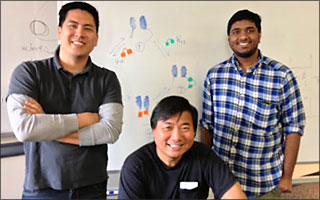Going native — biomedical engineers take biochemistry from the test tube into living cells

Classic biochemistry has long analyzed isolated biological molecules, or their fragments, within artificial solutions in test tubes. However, the results obtained may belie the actual behavior of these molecules as they function within live cells.
Ph.D. graduate students Philemon S. Yang and Manu Ben Johny, along with Johns Hopkins BME professor David T. Yue, have devised methods to translate traditional biochemistry approaches from the test-tube context into live cells — thus resolving a mystery about the regulation of ion-channel molecules that usher calcium ions into cells to orchestrate vital brain functions.
These advances not only reveal how calcium ion channels are properly controlled in the brain, but furnish a powerful new strategy for probing similarly large and complex molecules that abound throughout the body. The Hopkins team is adding to a growing biochemical toolkit to study native molecular function in live cells, essential equipment for a new era of biological discovery. These findings were published online on 1/19/2014 in the journal Nature Chemical Biology.
Calcium Transport Study: Details and Findings
Like cruise control on a car, the entry of calcium through these ion channels is delicately fine-tuned by the opposing control actions of two distinct binding partners: calmodulin and calcium-binding-protein. How these partners achieve the proper balance, however, has been puzzling.
From test-tube studies of isolated channel fragments, it appeared that calmodulin and calcium-binding-protein must compete for binding to the same site on channels, with occupancy by calmodulin or calcium-binding protein respectively accelerating or braking calcium entry. Paradoxically, calmodulin far outnumbers calcium-binding-protein throughout the brain, so it has been unclear how channels ever exit braking mode.
But what actually happens within intact channels, which are enormous molecules with extensive real estate, rendering them notoriously difficult to study en masse?
To understand what actually happens within intact ion channels, the Hopkins team devised a means to use light to measure the binding of calmodulin and calcium-binding-protein to intact ion channels in live cells. Additionally, single-cell electrical measurements were used quantify calcium-transport function of the channels.
Another innovation was to genetically engineer channels to be directly tethered to calmodulin, so as to guarantee calmodulin binding. Remarkably, the research team observed that calcium-binding-protein is still able to bind and accelerate calcium entry. Conversely, for channels tethered to calcium-binding-protein, calmodulin was also still able to bind.
Thus, calmodulin and calcium-binding-protein bind to separate molecular brake and accelerator pedals. Mimicry of the action of calcium-binding-protein may prove useful for future drug discovery.
